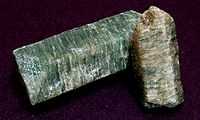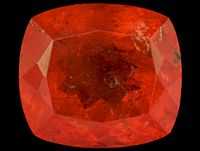Phosphate reactions

Phosphate reactions are chemical reactions that lead to the transformation of one set of phosphates into another.
Ions
Each of the phosphate ions: PO43-, hydrogen phosphate, HPO42-, and dihydrogen phosphate H2PO41- may form salts with one or more positive ions, or esters with one or more organics or organophosphates.
Solubility
Sodium, potassium, rubidium, cesium and ammonium phosphates are water soluble.
Hydrogen and dihydrogen phosphates may be slightly more soluble than their corresponding phosphates. The pyrophosphates are mostly water soluble.
Orthophosphoric acids
Def. "[a] colourless liquid, H3PO4"[1] is called phosphoric acid.
Def. "[o]rdinary phosphoric acid, H3PO4", after orthophosphoric acid, is called orthophosphoric acid.
"Orthophosphoric acid is a non-toxic, inorganic, rather weak triprotic acid, [that] is a very polar molecule ... soluble in water. ... Triprotic means that an orthophosphoric acid molecule can dissociate up to three times, giving up an H+ each time, which typically combines with a water molecule, H2O, as shown in these reactions:
- H3PO4(s) + H2O(l) <=> H3O+(aq) + H2PO4−(aq) Ka1= 7.25×10−3
- H2PO4−(aq)+ H2O(l) <=> H3O+(aq) + HPO42−(aq) Ka2= 6.31×10−8
- HPO42−(aq)+ H2O(l) <=> H3O+(aq) + PO43−(aq) Ka3= 3.98×10−13
The anion after the first dissociation, H2PO4−, is the dihydrogen phosphate anion. The anion after the second dissociation, HPO42−, is the hydrogen phosphate anion. The anion after the third dissociation, PO43−, is the phosphate or orthophosphate anion. For each of the dissociation reactions shown above, there is a separate acid dissociation constant, called Ka1, Ka2, and Ka3 given at 25 °C. Associated with these three dissociation constants are corresponding pKa1=2.12 , pKa2=7.21 , and pKa3=12.67 values at 25 °C."[2]
"For a given total acid concentration [A] = [H3PO4] + [H2PO4−] + [HPO42−] + [PO43−] ([A] is the total number of moles of pure H3PO4 which have been used to prepare 1 liter of solution), the composition of an aqueous solution of phosphoric acid can be calculated using the equilibrium equations associated with the three reactions described above together with the [H+][OH−] = 10−14 relation and the electrical neutrality equation. Possible concentrations of polyphosphoric molecules and ions is neglected. The system may be reduced to a fifth degree equation for [H+] which can be solved numerically, yielding:"[2]
| [A] (mol/L) | pH | [H3PO4]/[A] (%) | [H2PO4−]/[A] (%) | [HPO42−]/[A] (%) | [PO43−]/[A] (%) |
| 1 | 1.08 | 91.7 | 8.29 | 6.20×10−6 | 1.60×10−17 |
| 10−1 | 1.62 | 76.1 | 23.9 | 6.20×10−5 | 5.55×10−16 |
| 10−2 | 2.25 | 43.1 | 56.9 | 6.20×10−4 | 2.33×10−14 |
| 10−3 | 3.05 | 10.6 | 89.3 | 6.20×10−3 | 1.48×10−12 |
| 10−4 | 4.01 | 1.30 | 98.6 | 6.19×10−2 | 1.34×10−10 |
| 10−5 | 5.00 | 0.133 | 99.3 | 0.612 | 1.30×10−8 |
| 10−6 | 5.97 | 1.34×10−2 | 94.5 | 5.50 | 1.11×10−6 |
| 10−7 | 6.74 | 1.80×10−3 | 74.5 | 25.5 | 3.02×10−5 |
| 10−10 | 7.00 | 8.24×10−4 | 61.7 | 38.3 | 8.18×10−5 |
Pyrophosphoric acids
Def. the "[syrupy liquid] acid formed by the dehydration of [i.e., removing a molecule of water from] two molecules of phosphoric acid [to form one molecule of] H4P2O7"[3] is called pyrophosphoric acid.
Oligophosphoric acids
Def. a series of phosphoric acids condensed into one molecule when the number of phosphoric acids is small, per the general formula Hn+2PnO3n+1, where n is usually greater than 5, is called an oligophosphoric acid.[4]
Phosphates
Def. "[a]ny salt or ester of phosphoric acid"[5] is called phosphate.
Def. any "salt or ester of pyrophosphoric acid"[6] is called a pyrophosphate.
Def. "any of a class of inorganic polymers containing linked phosphate groups"[7] is called a polyphosphate.
Phosphate can occur as hydroxyapatite Ca5(PO4)3OH, which is often dissolved from vertebrate bones and teeth.
Phosphate minerals

Phosphorites
The phosphate content of phosphorite is at least 15 to 20% which is a large enrichment over the typical sedimentary rock content of less than 0.2%.[8] The phosphate is present as fluorapatite Ca5(PO4)3F typically in cryptocrystalline masses (grain sizes < 1 μm) referred to as collophane.[8]
Limestones and mudstones are common phosphate bearing rocks.[9]
Bio-organics
Inside a cell, phosphate may be structural to a nucleic acid such as DNA, RNA or phospholipid, form high-energy ester bonds (e.g., in adenosine triphosphate), or participate in signaling. Outside the cell, phosphate may be dissolved in extracellular fluid (ECF) or form structures such as bone and teeth.
Bio-organic phosphates
Notation: let the symbols ATP, CTP, GTP, NTP, and UTP stand for adenosine triphosphate, cytidine triphosphate, guanosine triphosphate, nucleotide triphosphate, and uridine triphosphate, respectively.
Notation: let the symbols ADP, CDP, GDP, NDP, and UDP stand for adenosine diphosphate, cytidine diphosphate, guanosine diphosphate, nucleotide diphosphate, and uridine diphosphate, respectively.
Notation: let the symbols AMP, CMP, GMP, NMP, and UMP stand for adenosine monophosphate, cytidine monophosphate, guanosine monophosphate, nucleotide monophosphate, and uridine monophosphate, respectively.
Phosphorylation
Def. "the process of transferring a phosphate group from a donor to an acceptor; often catalysed by enzymes"[10] is called phosphorylation.
Phosphorylase a
4ATP + 2(Phosphorylase b) <=> 4ADP + (Phosphorylase a) : [glycogen phosphorylase] phosphotransferase EC 2.7.11.19 R00076.[11]
Human GeneID: 801
CALM1; calmodulin 1 (phosphorylase kinase, delta) (EC:2.7.11.19); K02183 calmodulin,
Human GeneID: 5255
PHKA1; phosphorylase kinase, alpha 1 (muscle) (EC:2.7.11.19); K07190 phosphorylase kinase alpha/beta subunit,
Human GeneID: 5256
PHKA2; phosphorylase kinase, alpha 2 (liver) (EC:2.7.11.19); K07190 phosphorylase kinase alpha/beta subunit,
Human GeneID: 5260
PHKG1; phosphorylase kinase, gamma 1 (muscle) (EC:2.7.11.19); K00871 phosphorylase kinase gamma subunit [EC:2.7.11.19],
Human GeneID: 5261
PHKG2; phosphorylase kinase, gamma 2 (testis) (EC:2.7.11.19); K00871 phosphorylase kinase gamma subunit [EC:2.7.11.19].
Enzyme activators:
- Ca2+
- calmodulin
2(Phosphorylase b) + 4Orthophosphate (Pi) <=> Phosphorylase a + 4H2O : [glycogen phosphorylase] phosphohydrolase EC 3.1.3.17 R00077, no genes.[12]
Nicotinamide adenine dinucleotide
Nicotinamide + ADP-ribose <=> NAD+ + H2O : NAD+ glycohydrolase R00102.[13]
EC 3.2.2.5
Human GeneID: 683
BST1; bone marrow stromal cell antigen 1 (EC:3.2.2.5); K01242 NAD+ nucleosidase [EC:3.2.2.5],
Human GeneID: 952
CD38; CD38 molecule (EC:3.2.2.5); K01242 NAD+ nucleosidase [EC:3.2.2.5],
EC 3.2.2.6 no genes.
AMP + Nicotinamide D-ribonucleotide <=> NAD+ + H2O : NAD+ phosphohydrolase R00103.[14]
EC 3.6.1.9
Human GeneID: 5169
ENPP3; ectonucleotide pyrophosphatase/phosphodiesterase 3 (EC:3.1.4.1 3.6.1.9); K01113 phosphodiesterase/alkaline phosphatase D [EC:3.1.4.1]; K01513 nucleotide pyrophosphatase [EC:3.6.1.9]
Human GeneID: 5167
ENPP1; ectonucleotide pyrophosphatase/phosphodiesterase 1 (EC:3.1.4.1 3.6.1.9); K01113 phosphodiesterase/alkaline phosphatase D [EC:3.1.4.1]; K01513 nucleotide pyrophosphatase [EC:3.6.1.9]
EC 3.6.1.22
Human GeneID: 83594
NUDT12; nudix (nucleoside diphosphate linked moiety X)-type motif 12 (EC:3.6.1.22); K03426 NAD+ diphosphatase [EC:3.6.1.22]
ATP + Nicotinamide D-ribonucleotide <=> Diphosphate + Nicotinamide adenine dinucleotide (NAD+) : nicotinamide-nucleotide adenylyltransferase EC 2.7.7.1 R00137.[15]
Human GeneID: 23057
NMNAT2; nicotinamide nucleotide adenylyltransferase 2 (EC:2.7.7.1 2.7.7.18); K00952 nicotinamide-nucleotide adenylyltransferase [EC:2.7.7.1]
Human GeneID: 64802
NMNAT1; nicotinamide nucleotide adenylyltransferase 1 (EC:2.7.7.1 2.7.7.18); K00952 nicotinamide-nucleotide adenylyltransferase [EC:2.7.7.1]
Human GeneID: 349565
NMNAT3; nicotinamide nucleotide adenylyltransferase 3 (EC:2.7.7.1 2.7.7.18); K00952 nicotinamide-nucleotide adenylyltransferase [EC:2.7.7.1]
Nicotinate nucleotide can also act as an electron acceptor in place of Nicotinamide D-ribonucleotide.[16]
and
ATP + Nicotinate ribonucleotide <=> Diphosphate + Deamido-NAD+ EC 2.7.7.18 same human genes as EC 2.7.7.1.
Nicotinamide adenine dinucleotide phosphate
Nicotinamide + ADPribose 2'-phosphate <=> NADP+ + H2O : NADP+ glycohydrolase R00119.[17]
EC 3.2.2.5
Human GeneID: 683
BST1; bone marrow stromal cell antigen 1 (EC:3.2.2.5); K01242 NAD+ nucleosidase [EC:3.2.2.5]
Human GeneID: 952
CD38; CD38 molecule (EC:3.2.2.5); K01242 NAD+ nucleosidase [EC:3.2.2.5]
EC 3.2.2.6 no genes
Coenzyme A
Notation: let Coenzyme A be represented by CoA
ATP + Dephospho-CoA <=> ADP + CoA : dephospho-CoA 3'-phosphotransferase EC 2.7.1.24 R00130,[18]
Human GeneID: 80347
COASY; Coenzyme A synthase (EC:2.7.7.3, 2.7.1.24); K00859 dephospho-CoA kinase [EC:2.7.1.24]; K02201 pantetheine-phosphate adenylyltransferase [EC:2.7.7.3].
2'-Deoxy-5-hydroxymethylcytidine-5'-triphosphate
2'-Deoxy-5-hydroxymethylcytidine-5'-diphosphate + ATP <=> 2'-Deoxy-5-hydroxymethylcytidine-5'-triphosphate + ADP : 2'-deoxy-5-hydroxymethylcytidine-5'-diphosphate phosphotransferase EC 2.7.4.6 R00139, same human genes as R00124.
Hydroxymethylcytidine-5'-diphosphate
5-Hydroxymethyldeoxycytidylate + ATP <=> Hydroxymethylcytidine-5'-diphosphate + ADP : 5-hydroxymethyldeoxycytidylate phosphotransferase EC 2.7.4.12 R00140, no human genes.
Phosphoramidate
ATP + NH3 <=> ADP + Phosphoramidate : ammonia phosphotransferase EC 2.7.3.8 R00141, no genes.
Research
Hypothesis:
- Phosphate reactions may have been the initiator of life.
Control groups

The findings demonstrate a statistically systematic change from the status quo or the control group.
“In the design of experiments, treatments [or special properties or characteristics] are applied to [or observed in] experimental units in the treatment group(s).[19] In comparative experiments, members of the complementary group, the control group, receive either no treatment or a standard treatment.[20]"[21]
Proof of concept
Def. a “short and/or incomplete realization of a certain method or idea to demonstrate its feasibility"[22] is called a proof of concept.
Def. evidence that demonstrates that a concept is possible is called proof of concept.
The proof-of-concept structure consists of
- background,
- procedures,
- findings, and
- interpretation.[23]
See also
References
- ↑ "phosphoric acid, In: Wiktionary". San Francisco, California: Wikimedia Foundation, Inc. June 17, 2013. Retrieved 2013-08-23.
- 1 2 "Phosphoric acid, In: Wikipedia". San Francisco, California: Wikimedia Foundation, Inc. August 19, 2013. Retrieved 2013-08-22.
- ↑ "pyrophosphoric acid, In: Wiktionary". San Francisco, California: Wikimedia Foundation, Inc. June 18, 2013. Retrieved 2013-08-23.
- ↑ E. Wiberg, N. Wiberg, and A. F. Holleman (2001). Inorganic Chemistry. Academic Press. pp. 1884.
- ↑ "phosphate, In: Wiktionary". San Francisco, California: Wikimedia Foundation, Inc. August 19, 2013. Retrieved 2013-08-23.
- ↑ "pyrophosphate, In: Wiktionary". San Francisco, California: Wikimedia Foundation, Inc. June 18, 2013. Retrieved 2013-08-23.
- ↑ "polyphosphate, In: Wiktionary". San Francisco, California: Wikimedia Foundation, Inc. June 18, 2013. Retrieved 2013-08-23.
- 1 2 Blatt, Harvey and Robert J. Tracy, Petrology, Freeman, 1996, 2nd ed. pp. 345-349 ISBN 0-7167-2438-3
- ↑ Prothero, Donald R.2004,1996. Sedimentary Geology An Intro to Sedimentary Rocks and Straitagraphy Second Edition. W.H. Freeman and Company New York. 265-269
- ↑ "phosphorylation, In: Wiktionary". San Francisco, California: Wikimedia Foundation, Inc. 9 December 2014. Retrieved 2014-12-10.
- ↑ "KEGG REACTION: R00076".
- ↑ "KEGG REACTION: R00077".
- ↑ "KEGG REACTION: R00102".
- ↑ "KEGG REACTION: R00103".
- ↑ "KEGG REACTION: R00137".
- ↑ "ExPASy Proteomics Server NiceZyme View of ENZYME: EC 2.7.7.1".
- ↑ "KEGG REACTION: R00119".
- ↑ "KEGG REACTION: R00130".
- ↑ Klaus Hinkelmann, Oscar Kempthorne (2008). Design and Analysis of Experiments, Volume I: Introduction to Experimental Design (2nd ed.). Wiley. ISBN 978-0-471-72756-9. http://books.google.com/?id=T3wWj2kVYZgC&printsec=frontcover.
- ↑ R. A. Bailey (2008). Design of comparative experiments. Cambridge University Press. ISBN 978-0-521-68357-9. http://www.cambridge.org/uk/catalogue/catalogue.asp?isbn=9780521683579.
- ↑ "Treatment and control groups, In: Wikipedia". San Francisco, California: Wikimedia Foundation, Inc. May 18, 2012. Retrieved 2012-05-31.
- ↑ "proof of concept, In: Wiktionary". San Francisco, California: Wikimedia Foundation, Inc. November 10, 2012. Retrieved 2013-01-13.
- ↑ Ginger Lehrman and Ian B Hogue, Sarah Palmer, Cheryl Jennings, Celsa A Spina, Ann Wiegand, Alan L Landay, Robert W Coombs, Douglas D Richman, John W Mellors, John M Coffin, Ronald J Bosch, David M Margolis (August 13, 2005). "Depletion of latent HIV-1 infection in vivo: a proof-of-concept study". Lancet 366 (9485): 549-55. doi:10.1016/S0140-6736(05)67098-5. http://www.ncbi.nlm.nih.gov/pmc/articles/PMC1894952/. Retrieved 2012-05-09.
External links
- Hit counter To see how often this page is viewed, enter Wikiversity, then the page title.
- GenomeNet KEGG database
- Home - Gene - NCBI
- PubChem Public Chemical Database
- WikiDoc The Living Textbook of Medicine
| |||||||||||||||||||||||||||||||||||
![]() This is a research project at http://en.wikiversity.org
This is a research project at http://en.wikiversity.org
| |
Development status: this resource is experimental in nature. |
| |
Educational level: this is a research resource. |
| |
Resource type: this resource is an article. |
| |
Resource type: this resource contains a lecture or lecture notes. |
| |
Subject classification: this is a biochemistry resource. |